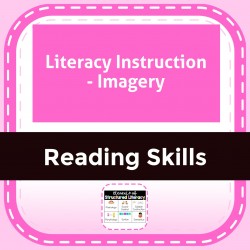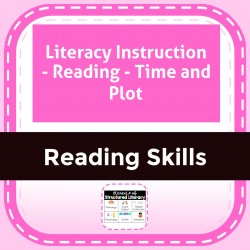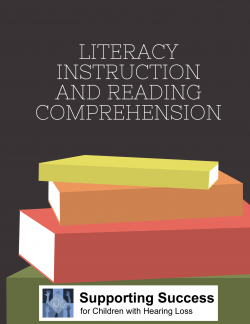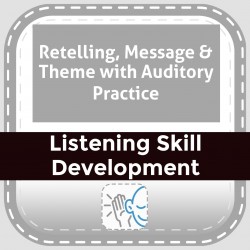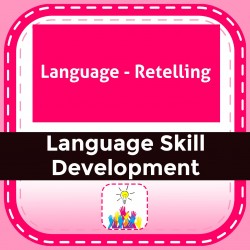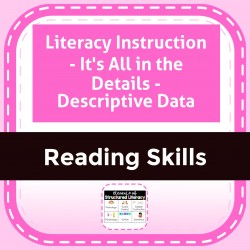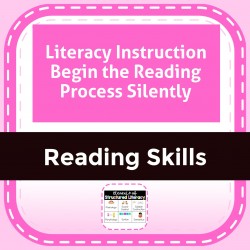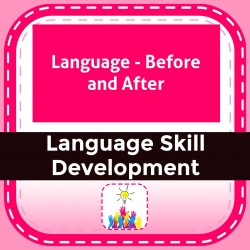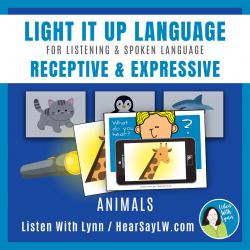Ability Levels
Categories
Resource Types
Age/Grade Range
CCSS
Anchor Standard
Speaking & Listening
Language
Reading
Literacy Instruction - Imagery
$ 195
Imagery is the creation of a representation of an idea or concept in the mind. These instructional strategies include ways to improve reading comprehension by using vocabulary knowledge and learning
...
to create mental images.
Language - Intensity by Degree 1
$ 195
Explains that intensity represents a change in complexity for any area of learning. Uses visualizing, rating scales, sequencing, and graphic organizers.
Literacy Instruction - Reading - Time and Plot
$ 195
Understanding ‘time’ plays a key role in comprehension of each element of literature. Time marks the movement of action within the story. It also marks changes within the story. These instructional s
...
al strategies focus on character's feelings and how they are related to behaviors, conflict, and action in the story. Activities include identifying transition words that indicate movement of time, sequencing characters' actions within the story, writing sentences with transition words, and using tense markers.
Literacy Instruction Reading Comprehension
$ 195
Reading comprehension is the process of combining thinking with text to construct meaning from written language. Instructional strategies and activities including accessing prior knowledge to, questi
...
oning, inferring, visualizing, summarizing, and synthesizing.
Retelling, Message & Theme with Auditory Practice
$ 295
Students demonstrate auditory comprehension of text that is read to them by retelling and/or identifying message or theme. Suggests questions about student's listening skills to consider when planning
...
instruction. Includes retelling wheel, rubric, retelling prompt cards, common message/moral/theme cards, 2 international folk tales, activities responding to Casey at the Bat with suggestions for extending learning.
Language - Retelling
$ 295
Explanation to parents and teachers about the importance of retelling and sequencing events. Worksheets include: sequencing stages of a butterfly, retelling events of the school day, finding the begin
...
ning, middle and ending of a story, fiction and non-fiction reader response forms.
Literacy Instruction - It's All in the Details - Descriptive Data
$ 195
The most important reading skill is determining the main idea of a passage. Closely linked to this is the understanding of supporting details. Supporting details clarify and expand understanding of th
...
e main idea. These pages give instructional strategies for teaching descriptive detail. Activities include passage analysis, recognizing personification, identifying descriptors, and writing job descriptions using adjectives.
Literacy Instruction Begin the Reading Process Silently
$ 2
These instructional strategies for developing students' silent reading skills including making connections, asking questions, visualizing, determining text importance, inferencing, and synthesizing.
Language - Before and After
$ 2
As part of understanding routine, a student needs to recognize and use the prepositions ‘before’ and ‘after’ effectively to demonstrate sequence of events. This activity is organized from simple to co
...
le to complex language structure.
ANIMALS Auditory Processing Receptive & Expressive Language
$ 5
You'll love the ANIMALS version of Light It Up Language! Kids listen to clues presented through hearing alone to identify 16 hidden ANIMALS vocabulary pictures. Each of the pictures has four clues th
...
ues that are increasingly more specific.The magic happens by lighting up the “What Do You Hear?” cards. Hidden pictures are held up to a flashlight and the ANIMALS images amazingly appear. How fun! Once the hidden picture is revealed the child recalls and uses the clues to describe the ANIMALS. Thereby stretching their auditory memory, descriptive language, and expressive language skills.TARGETS: RECEPTIVE: This game builds critical thinking and reasoning skills by categorizing, making inferences, and drawing conclusions. EXPRESSIVE: The child recalls and uses clues to describe the hidden object. INCLUDES:✧ Listening & language guide with instructions✧ Target or goal suggestions✧ 8 What Do You Hear? cards (printed twice)✧ 16 Hidden ANIMALS Picture Vocabulary Cards✧ 64 Prompt Clues - 16 objects with four details each that get increasingly more specific✧ A Script with scaffolding strategies✧ Listening and Spoken Language Tips ➼ EASY one-time quick game prep and you're all set to use year after year. ➼ You’ll need a FLASHLIGHT, a lamp, or a sunny window.◈ ◈ ◈ ◈ ◈ ◈ ◈ ◈ ◈ ◈ ◈ ◈ ◈ ◈ ◈ ◈ ◈ ◈ ◈ ◈ ◈ CUSTOMER TIPS:➼ Questions? Please email me before purchasing this resource or anytime later.♥ Sign-up HERE for the Listen With Lynn emails♥ For more ideas visit my blog: HearSayLW.comSTAY CONNECTED:✧ Sign-up here for the Listen With Lynn emails✧ Follow on Facebook - Lynn A. Wood - LSL Auditory Verbal Therapist and Rehab Audiologist✧ Follow on Instagram @auditoryverbal_listenwithlynn❤ Keep up your excellent work. I am blessed to help along the way. Thanks so much!Lynn Wood
 Your browser is out of date. For best experience switch to latest updated Browser.
Your browser is out of date. For best experience switch to latest updated Browser.
 Get Chrome
Get Chrome Get Edge
Get Edge Get Firefox
Get Firefox